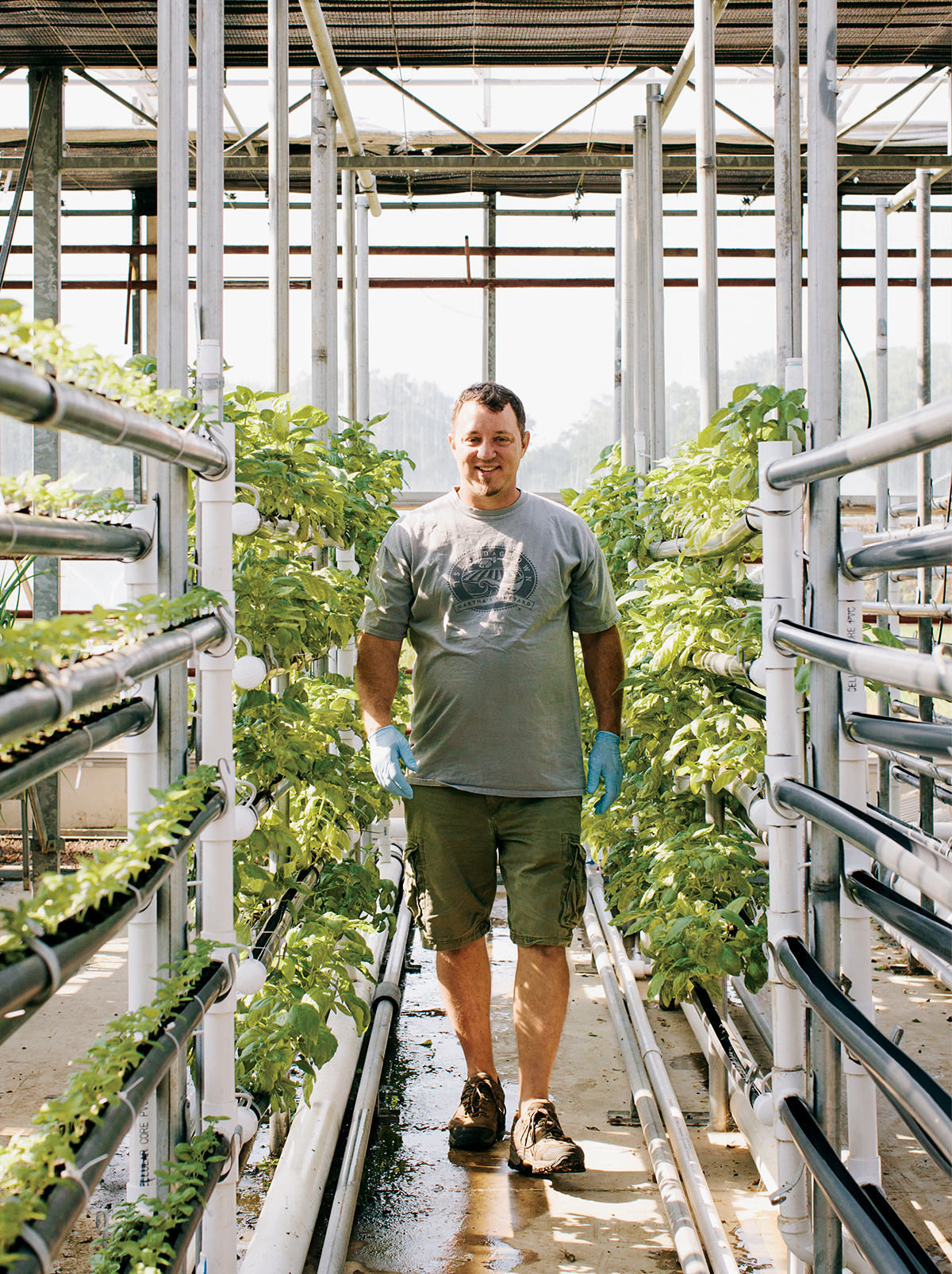Buying the Farm on Martha’s Vineyard

Keith Wilda, Island Grown Initiative’s executive director, took over the Thimble Farm operation in 2013. / Photograph by Elizabeth Cecil
The land known as Thimble Farm, just off Head of the Pond Road near the northern coast of Martha’s Vineyard, has been in agriculture for nearly 300 years, dating back to when the island was mostly farmland and pasture. Until 1981, it was part of a family-owned dairy that at its peak spanned 600 acres. Then, for a time, it was home to a successful pick-your-own berry operation and a 31,000-square-foot greenhouse. As the Vineyard’s summer-vacation cachet grew, one by one the island’s farms were lost to housing. By 2000, Thimble Farm’s owners, off-islanders who had moved there to live the simple life, were preparing to retire. But before they put the property on the market, they made a deal with a quasi-governmental conservation authority called the Martha’s Vineyard Land Bank, which paid $1 million to preserve the land under the condition that it remain a farm—a deal known as an agricultural preservation restriction (APR). But in 2007, the landlord accepted an offer from a buyer who wanted to transform Thimble Farm into an estate with horses—kosher under the terms of the APR, if not in keeping with its spirit.
The pending deal made the papers, and the agricultural community bemoaned the pending demise of yet another Vineyard farm. Then, in stepped Eric Grubman, an NFL executive vice president who summers in Edgartown; he wrote a $2.45 million check to keep the land in food production. A coalition of local conservation and community groups, including one called Island Grown Initiative, organized to try to take the farm off his hands. But they could never raise quite enough cash, and Grubman grew tired of holding onto the land. Once again, the property was in danger of becoming a horse ranch.
That sounded like a shame to Mary Kenworth, who co-owns State Road restaurant, in West Tisbury. (The Obamas have been known to dine there on date night.) Kenworth, an Island Grown board member, mentioned the farm’s plight to her friend Allan Holt, a managing director of a Washington, DC–based private equity firm. Holt and his wife, Shelley, summer at a 9,000-square-foot, $16 million cottage in Chilmark and are known for their eclectic philanthropy around the island. In 2012, the Holts helped Island Grown Initiative buy Thimble Farm for $2.6 million.
But that was just the beginning of Island Grown’s ambitions. Founded in 2005 as a nonprofit cheerleader for local food, it had, up until then, limited itself to promoting the Vineyard’s remaining farms and getting more local produce into stores, restaurants, and schools; it had never owned land. Now, to fulfill its vision for Thimble Farm, the nonprofit began working to raise as much as $12 million. The money would be used to build a cut-and-pack facility, a commercial kitchen, housing for farm workers, and offices for Island Grown’s staff. But the most expensive element—and the most controversial—would be a slaughterhouse.
It’s March, and a thick blanket of snow still covers the fields. Inside the rehabilitated greenhouse at Thimble Farm, however, the air feels almost tropical, and a clean, vegetal scent rises from thousands of tiny lettuces poking out of neat holes in hydroponic tables. “Try a cherry tomato,” urges Keith Wilda, plucking the ripe fruit from a vine.
Wilda is Island Grown Initiative’s executive director, a genius of indoor agriculture who grew up on a vegetable farm in western Massachusetts and moved to the Vineyard to head up the Thimble Farm operation in 2013. This winter, he has coaxed tomatoes, peppers, cucumbers, and even strawberries into fruit. Normally taciturn, Wilda becomes animated when he wades into policy issues around food and farming. “Our goal is to increase the local food in the food system,” he says. “A local food system is important—we spend a lot of money and time shipping food around the world,” he adds. “This really could be a model for [how to change] that, if you look at every community as an island.”
As it stands, though, as little as 3 percent of the island’s food is self-produced. Farming is a tough way to make a living in Massachusetts, where two-thirds of farms gross less than $10,000 a year, and only half of the state’s farmers report that agriculture is their primary occupation. On the Vineyard, where the economy goes dormant for much of the year, it can be even tougher. Everything—housing, gasoline, tractor parts—is much more expensive here than on the mainland, and incomes are about 30 percent lower. Given the skyrocketing cost of land, the Vineyard’s 40-odd farms are very small. “There’s an incredible amount of demand that’s not being met,” says Noli Taylor, a food activist and Island Grown program leader who lives on the Vineyard year round.
In theory, Martha’s Vineyard should be an ideal place to grow a local food economy. The island’s isolation means it ought to be cheaper to produce food here than to import it from the mainland. And Vineyard farming should be better for the environment, since it ostensibly takes less fossil fuel to move regionally grown produce and meat than food brought in by truck, plane, or boat. But beyond that, many residents think local food just tastes better, and is often healthier than mass-produced agricultural products. Not to mention the fact that the money spent on it—by full-time residents and vacationers—stays on the island. And, at least in the summer, the market for local food is inexhaustible.
But there are also significant impediments to producing food on the island.
Currently, Vineyard farmers have to ferry their animals to the mainland for butchering, an expensive, counterintuitive process that seems to defeat the purpose of raising livestock locally. So in theory, Island Grown’s slaughterhouse should improve things for everyone: make it cheaper for island farmers to get their meat to market, help the environment, and keep island dollars on the island.
But instead, farmers and their year-round neighbors—Island Grown’s putative constituents—have lined up in opposition to the plan. The slaughterhouse, they say, is just as boutique-y as the rest of the nonprofit farming operation that’s pushing it. Neighbors argue that the slaughterhouse, as an industrial facility, will violate zoning laws, overtax local roads, and threaten nearby wetlands. A group with the somewhat confusing name Farm Partners has organized to stop it, protesting—in the words of Keith Proper, a Tisbury carpenter who has lived across the road from Thimble Farm for 36 years—that “it’s not a farm. It’s unprecedented development.” As the nonprofit grows, critics fear it is becoming a competitor to the very farms it was formed to protect.
On an island where development is a dirty word—and notoriously difficult—Island Grown still has some big hurdles to clear. It must seek approval before the Martha’s Vineyard Commission, the powerful regional planning agency, but even if the project does get approved, Farm Partners is prepared to challenge the development in court. Whether or not the controversy ends up in front of a judge, the kerfuffle between Island Grown’s well-heeled, nonprofit do-gooders and the Vineyard’s actual year-round farmers points to a widening chasm between the ideals of farm-to-fork—and the reality of what it takes to get local food on local tables.


